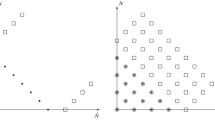Summary
The colourSU 3 and flavourU 1 ⊗SU 2 groups are unified into one underlying basicSU 2 symmetry in analogy to spinSU 2 and orbitalSO 3 merging into one rotation symmetry. Charge is the 3rd generator of this basicSU 2 and serves as a hinge of the groups effectively used,e.g. SU 4 ⊗SU R,2 ⊗SU L,3. The dynamical reason for the proliferation of the basicSU 2 is a hierarchical breakdown leading—qualitatively—to an « onion structure of symmetries » in which the « skins » of the onion are the different aspects of the basicSU 2,i.e. the groups effectively used. The breakdown-induced masses separate—quantitatively—the different groups merging together if the energies cross those masses.
Riassunto
Si unificano i gruppi di colore SU3 e di sapore U1 e SU2 in una simmetria sottostante di base SU2 in analogia con i gruppi di spin SU2 e orbitale SU3 che si f ondono in una simmetria di rotazione. La carica è il terzo generatore di questo SU2 di base e serve come cardine dei gruppi effettivamente usati,e.g. SU4 0 SUR,20 SUL,2. La ragione dinamica della proliferazione del gruppo SU2 di base è una rottura gerarcnica che porta — qualitativamente — a una « struttura a cipolla delle simmetrie », dove le « bucce» della cipolla sono differenti aspetti del gruppo SU2 di base, cioè i gruppi effettivamente usati. Le masse indotte della rottura separano quantitativamente i differenti gruppi che si fondono insieme se le energie attraversano quelle masse.
РЕжУМЕ
гРУппы цВЕтА SU3 И АРОМА тА U1 ⊗ SU2 ОБЩЕДИНьУтсь В ОДНУ О сНОВНУУ SU2 сИММЕтРИУ пО АНАлОг ИИ сО спИНОВОИ SU2 И ОРБИ тАльНОИ SO3, слИВАУЩИхсь В ОДНУ РОтАцИОННУУ сИ ММЕтРИУ. жАРьД пРЕДст АВльЕт тРЕтИИ гЕНЕРАтОР ЁтО И ОсНОВНОИ SU2 И слУжИт, кА к сОЕДИНЕНИЕ ЁтИх гРУ пп, т.Е. SU4 ⊗ SUR,2 ⊗ SUL,2. ДИНАМИЧЕскАь пРИЧИНА Дль пРОлИФЕР АцИИ ОсНОВНОИ SU2 Есть ИЕРАРхИЧЕскОЕ НАРУш ЕНИЕ, пРИВОДьЩЕЕ кАЧЕстВЕ ННО к «лУкОВИЧНОИ стР УктУРЕ сИММЕтРИИ», гДЕ «лУкО ВИЧНАь шЕлУхА» пРЕДстАВльЕ т РАжлИЧНыЕ АспЕкты О сНОВНОИ SU2, т.Е. к ЁФФЕктИВНО ИспОл ьжУЕМыМ гРУппАМ. ЁтО НАРУшЕНИ Е ВыжыВАЕт РАжДЕлЕНИ Е МАсс — кОлИЧЕстВЕННО РАжл ИЧНыЕ гРУппы слИВАУтсь ВМЕ стЕ, ЕслИ ЁНЕРгИИ пЕРЕ сЕкАУт ЁтИ МАссы.
Similar content being viewed by others
References
T. Kaluza:Sitzungsber. Preuss. Akad. Wiss. Phys. Math. Kl., 966 (1921);O. Klein:Z. Phys.,37, 895 (1926);Y. K. Cho andP. A. O. Freund:Phys. Rev. D,12, 1711 (1975).
H. Saller: preprint MPI-PAE/PTh 7/83 (January 1983).
H. P. Dürr:Properties of Matter under Unusual Conditions, edited byH.Mark andS. Feshbach (New York, N.Y., 1969).
H. P. Dürr andW. Heisenberg:Z. Naturforsch. Teil A,16, 726 (1961);W. Heisenberg:Introduction to the Unified Field Theory of Elementary Particles (New York, N.Y., 1966).
H. Saller:Nuovo Cimento A,30, 541 (1975);34, 99 (1976).
H. Saller:Nuovo Cimento A,7, 779 (1972);12, 349 (1972);24, 391 (1974).
H. Saller:Nuovo Cimento A,67, 70 (1982);68, 324 (1982).
H. Saller:Nuovo Cimento A,71, 17 (1982); preprint MPI-PAE/PTh 74/82.
J. C. Pati andA. Salam:Phys. Rev. D,8, 1240 (1973);E. Mohafatra andR. E. Marshak:Phys. Lett. B,91, 222 (1980);S. Rajpoot:Phys. Rev. D,22, 2244(1980).
H. Saller: preprint MPI-PAE/PTh 52/82, tobe published inNuovo Cimento.
H. P. Durr andH. Saller:Phys. Lett. B,84, 336 (1979);Nuovo Cimento A,53, 469 (1979);65, 147 (1981).
S. Mandelstam:Ann. Phys. (N.Y.),19, 1, 25 (1962);I. Bialynicki-Birula:Bull. Acta Polon. Sci.,10, 135 (1963).
P. Q. Hung andJ. J. Sakurai:Nucl. Phys. B,143, 81 (1978);J. D. Bjorken:Phys. Rev. D,19, 335 (1979).
H. P. Dürr andH. Saller:Phys. Rev. D,22, 1176 (1980).
H. Saller:Nuovo Cimento A,64, 141 (1981).
A. Salam:Proc. R. Soc. London, Ser. A,355, 515 (1977);M. Han andY. Nambu:Phys. Rev. B,139, 1006 (1965).
H. P. Dürr:Nuovo Cimento A,62, 69 (1981);65, 195 (1981).
S. Dimopoulos, S. Raby andL. Susskind:Nucl. Phys. B,173, 208 (1980).
V. L. Ginzburg andL. D. Landau:Zurn. ėksp. Teor. Fix. Pis’ma Red.,20, 1064 (1950);D. Saint-James, G. Sarma andE. J. Thomas:Type II Superconductivity (London, 1969).
G. ’T Hooft:Nucl. Phys. B,79, 276 (1974).
K. S. Stelle:Phys. Rev. D,16, 953 (1977).
Author information
Authors and Affiliations
Additional information
More general in the dramatically broken higher-symmetry schemes, may be also in supersymmetry.
Rights and permissions
About this article
Cite this article
Sallee, H. Colour as orbital isospin caused by a hierarchical symmetry breakdown. Nuov Cim A 77, 437–467 (1983). https://doi.org/10.1007/BF02903740
Received:
Published:
Issue Date:
DOI: https://doi.org/10.1007/BF02903740




